Accounting Information Systems: Cloud Computing Analysis (ACC2002)
VerifiedAdded on 2021/05/27
|9
|1774
|54
Report
AI Summary
This report examines the integration of cloud computing within accounting information systems (AIS). It begins with an overview of cloud computing, highlighting its benefits such as increased flexibility, real-time data access, and cost efficiency. The report then delves into the challenges of adopting cloud-based accounting systems, including data security risks, initial setup costs, and the need for businesses to assess their specific needs and regulatory frameworks. The benefits discussed include real-time updates, improved audit trails, and enhanced features. The report recommends that organizations carefully consider their business requirements, security needs, and the reliability of cloud service providers before adopting cloud-based AIS. It emphasizes a balanced approach, weighing the risks and rewards, and concludes that while both in-house and cloud-based systems have risks, the numerous advantages of cloud computing make it a crucial consideration for modern accounting practices.
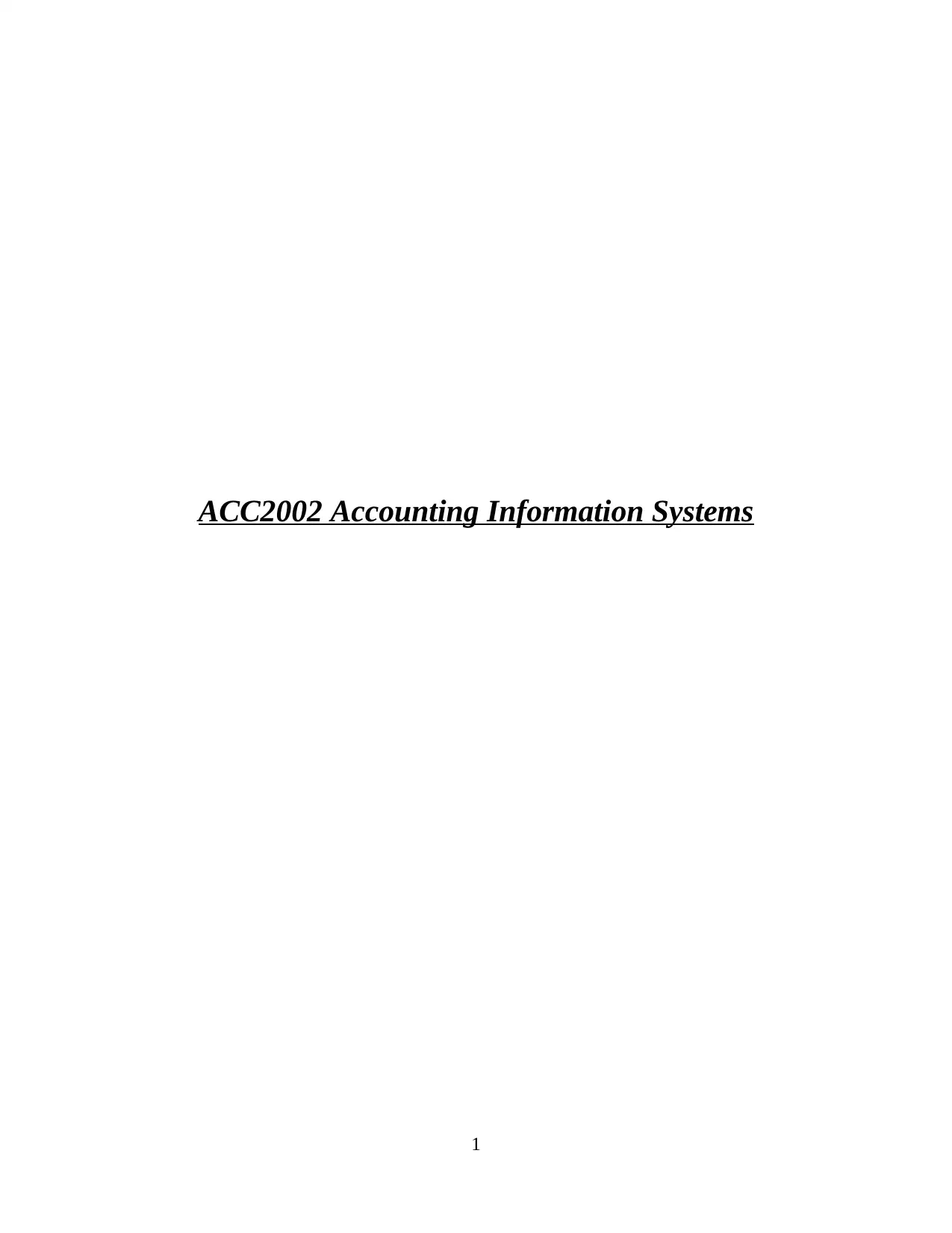
ACC2002 Accounting Information Systems
1
1
Secure Best Marks with AI Grader
Need help grading? Try our AI Grader for instant feedback on your assignments.
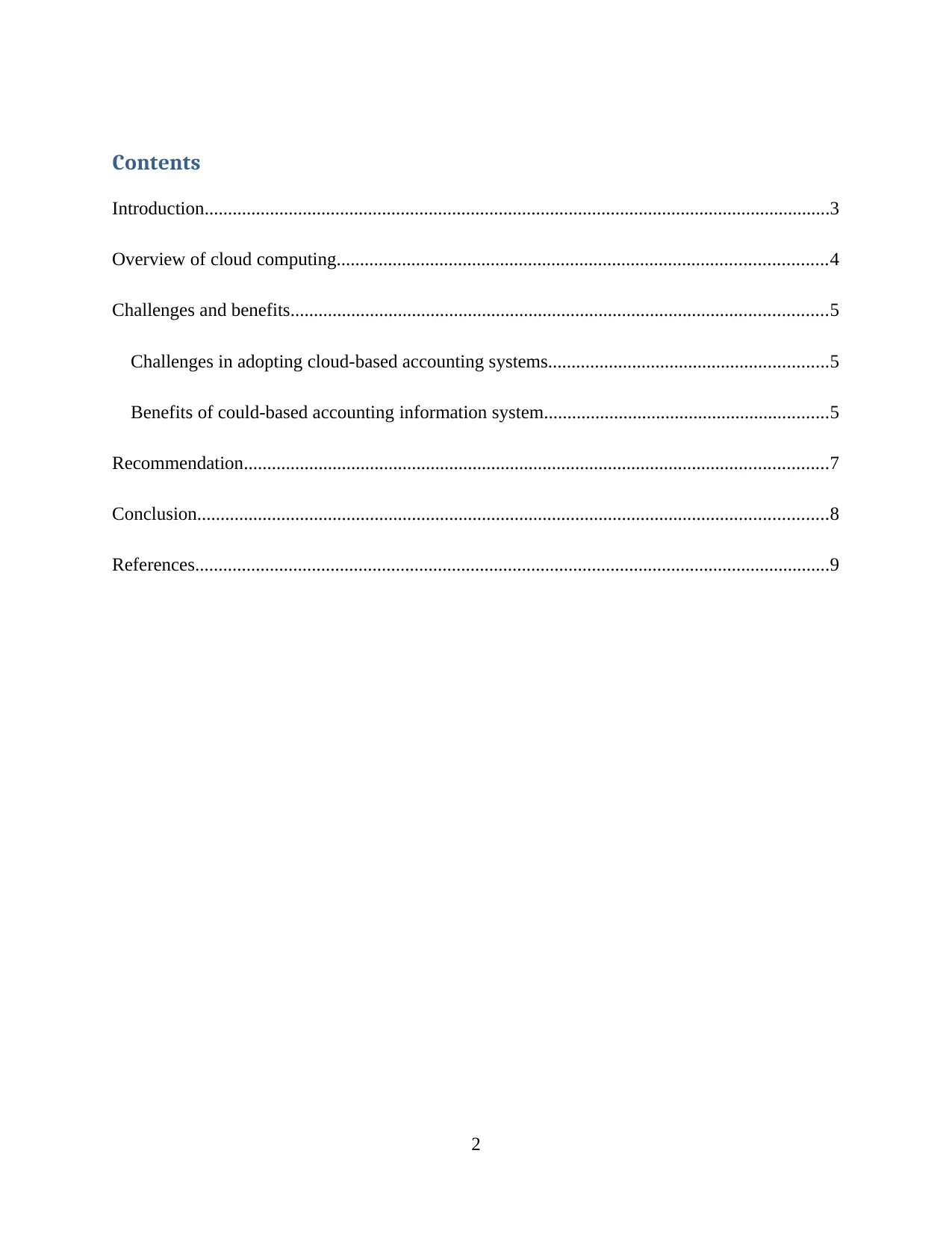
Contents
Introduction......................................................................................................................................3
Overview of cloud computing.........................................................................................................4
Challenges and benefits...................................................................................................................5
Challenges in adopting cloud-based accounting systems............................................................5
Benefits of could-based accounting information system.............................................................5
Recommendation.............................................................................................................................7
Conclusion.......................................................................................................................................8
References........................................................................................................................................9
2
Introduction......................................................................................................................................3
Overview of cloud computing.........................................................................................................4
Challenges and benefits...................................................................................................................5
Challenges in adopting cloud-based accounting systems............................................................5
Benefits of could-based accounting information system.............................................................5
Recommendation.............................................................................................................................7
Conclusion.......................................................................................................................................8
References........................................................................................................................................9
2
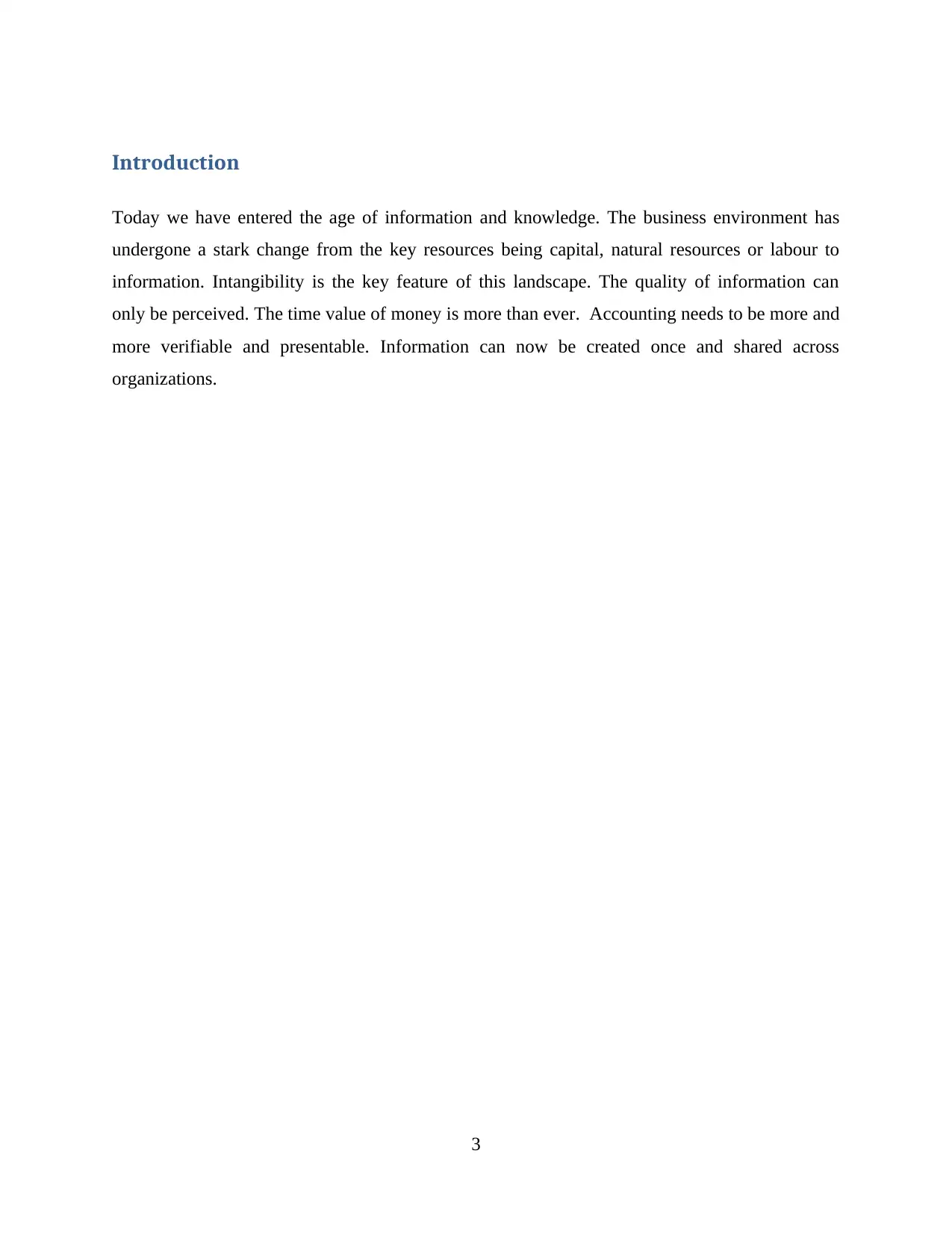
Introduction
Today we have entered the age of information and knowledge. The business environment has
undergone a stark change from the key resources being capital, natural resources or labour to
information. Intangibility is the key feature of this landscape. The quality of information can
only be perceived. The time value of money is more than ever. Accounting needs to be more and
more verifiable and presentable. Information can now be created once and shared across
organizations.
3
Today we have entered the age of information and knowledge. The business environment has
undergone a stark change from the key resources being capital, natural resources or labour to
information. Intangibility is the key feature of this landscape. The quality of information can
only be perceived. The time value of money is more than ever. Accounting needs to be more and
more verifiable and presentable. Information can now be created once and shared across
organizations.
3
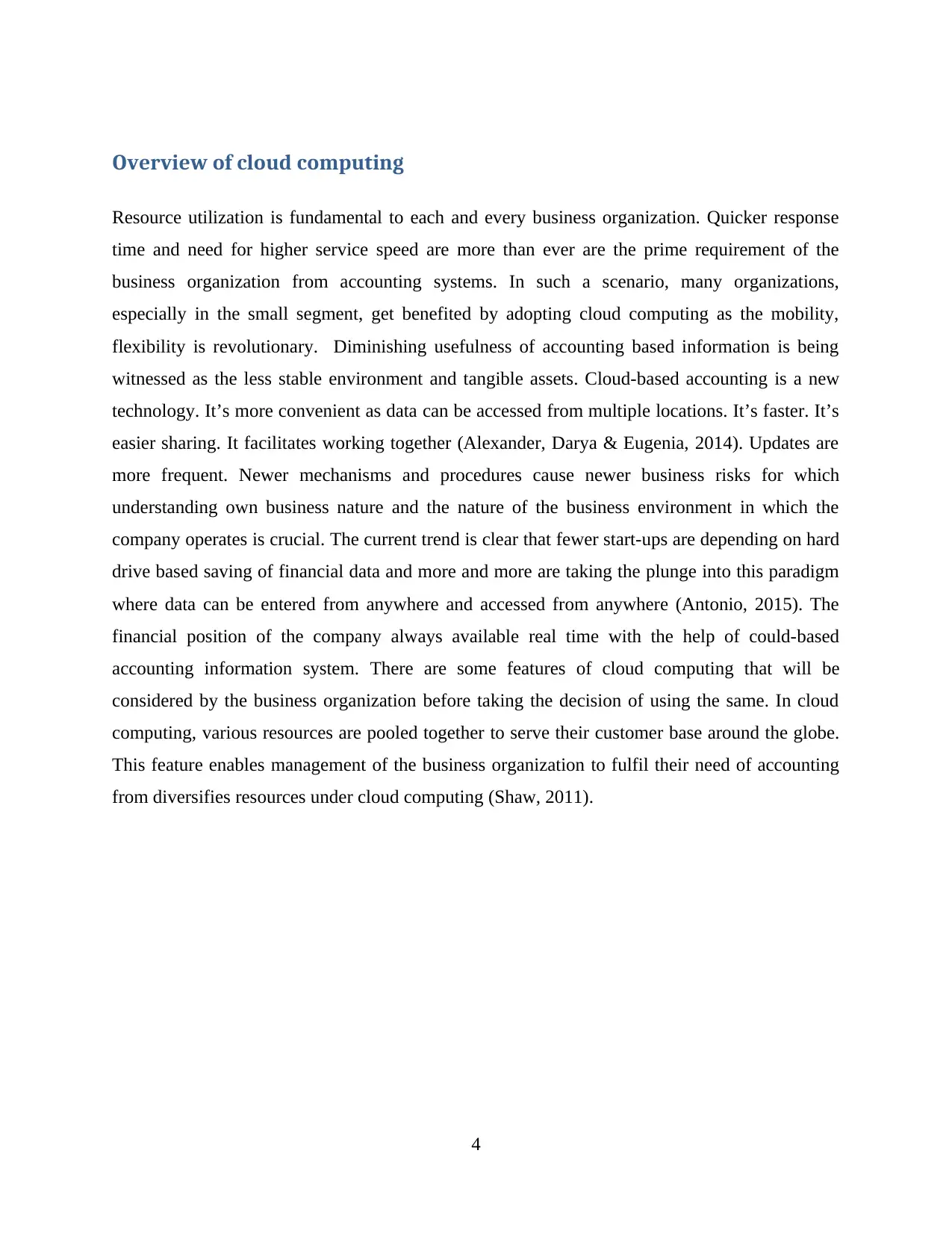
Overview of cloud computing
Resource utilization is fundamental to each and every business organization. Quicker response
time and need for higher service speed are more than ever are the prime requirement of the
business organization from accounting systems. In such a scenario, many organizations,
especially in the small segment, get benefited by adopting cloud computing as the mobility,
flexibility is revolutionary. Diminishing usefulness of accounting based information is being
witnessed as the less stable environment and tangible assets. Cloud-based accounting is a new
technology. It’s more convenient as data can be accessed from multiple locations. It’s faster. It’s
easier sharing. It facilitates working together (Alexander, Darya & Eugenia, 2014). Updates are
more frequent. Newer mechanisms and procedures cause newer business risks for which
understanding own business nature and the nature of the business environment in which the
company operates is crucial. The current trend is clear that fewer start-ups are depending on hard
drive based saving of financial data and more and more are taking the plunge into this paradigm
where data can be entered from anywhere and accessed from anywhere (Antonio, 2015). The
financial position of the company always available real time with the help of could-based
accounting information system. There are some features of cloud computing that will be
considered by the business organization before taking the decision of using the same. In cloud
computing, various resources are pooled together to serve their customer base around the globe.
This feature enables management of the business organization to fulfil their need of accounting
from diversifies resources under cloud computing (Shaw, 2011).
4
Resource utilization is fundamental to each and every business organization. Quicker response
time and need for higher service speed are more than ever are the prime requirement of the
business organization from accounting systems. In such a scenario, many organizations,
especially in the small segment, get benefited by adopting cloud computing as the mobility,
flexibility is revolutionary. Diminishing usefulness of accounting based information is being
witnessed as the less stable environment and tangible assets. Cloud-based accounting is a new
technology. It’s more convenient as data can be accessed from multiple locations. It’s faster. It’s
easier sharing. It facilitates working together (Alexander, Darya & Eugenia, 2014). Updates are
more frequent. Newer mechanisms and procedures cause newer business risks for which
understanding own business nature and the nature of the business environment in which the
company operates is crucial. The current trend is clear that fewer start-ups are depending on hard
drive based saving of financial data and more and more are taking the plunge into this paradigm
where data can be entered from anywhere and accessed from anywhere (Antonio, 2015). The
financial position of the company always available real time with the help of could-based
accounting information system. There are some features of cloud computing that will be
considered by the business organization before taking the decision of using the same. In cloud
computing, various resources are pooled together to serve their customer base around the globe.
This feature enables management of the business organization to fulfil their need of accounting
from diversifies resources under cloud computing (Shaw, 2011).
4
Secure Best Marks with AI Grader
Need help grading? Try our AI Grader for instant feedback on your assignments.
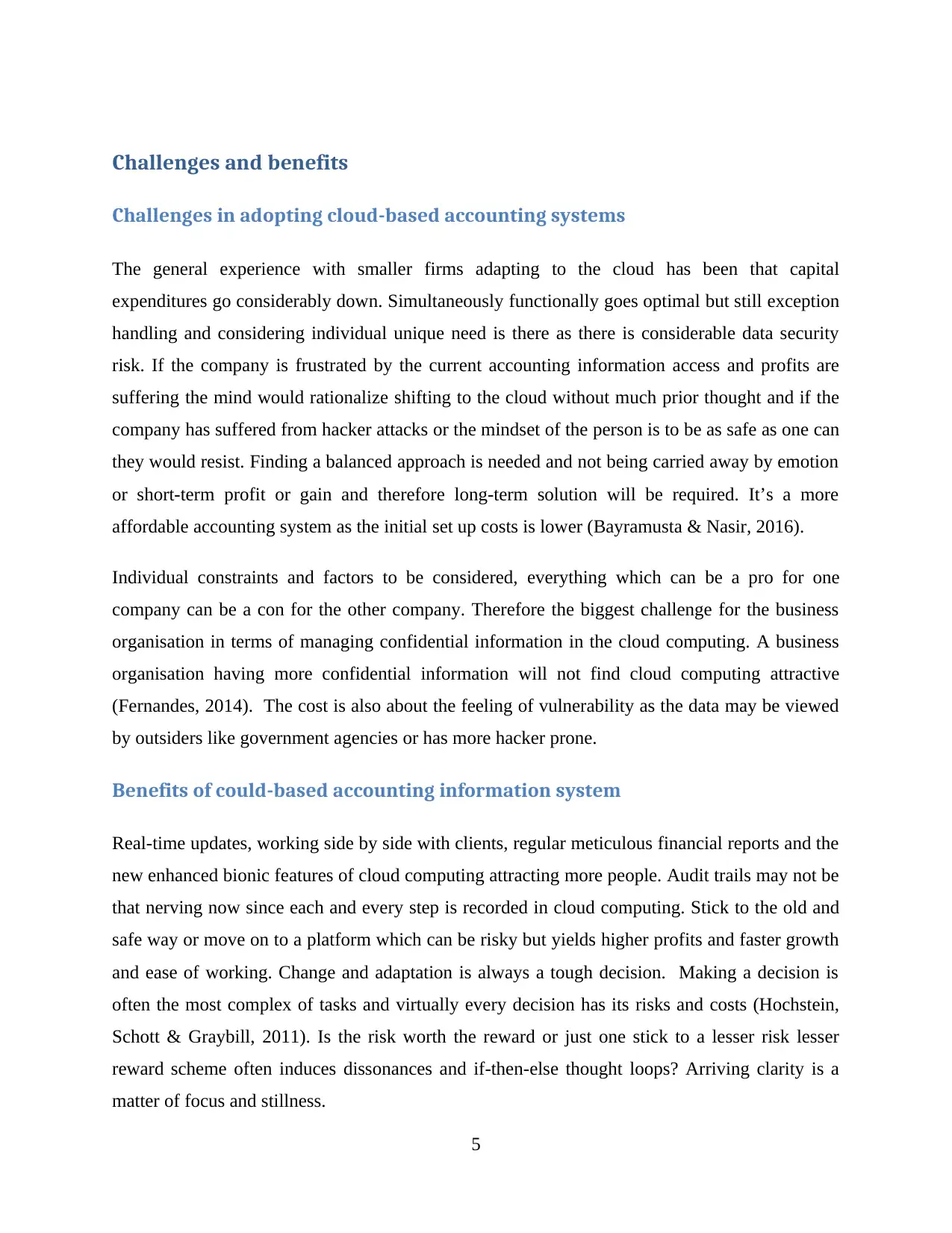
Challenges and benefits
Challenges in adopting cloud-based accounting systems
The general experience with smaller firms adapting to the cloud has been that capital
expenditures go considerably down. Simultaneously functionally goes optimal but still exception
handling and considering individual unique need is there as there is considerable data security
risk. If the company is frustrated by the current accounting information access and profits are
suffering the mind would rationalize shifting to the cloud without much prior thought and if the
company has suffered from hacker attacks or the mindset of the person is to be as safe as one can
they would resist. Finding a balanced approach is needed and not being carried away by emotion
or short-term profit or gain and therefore long-term solution will be required. It’s a more
affordable accounting system as the initial set up costs is lower (Bayramusta & Nasir, 2016).
Individual constraints and factors to be considered, everything which can be a pro for one
company can be a con for the other company. Therefore the biggest challenge for the business
organisation in terms of managing confidential information in the cloud computing. A business
organisation having more confidential information will not find cloud computing attractive
(Fernandes, 2014). The cost is also about the feeling of vulnerability as the data may be viewed
by outsiders like government agencies or has more hacker prone.
Benefits of could-based accounting information system
Real-time updates, working side by side with clients, regular meticulous financial reports and the
new enhanced bionic features of cloud computing attracting more people. Audit trails may not be
that nerving now since each and every step is recorded in cloud computing. Stick to the old and
safe way or move on to a platform which can be risky but yields higher profits and faster growth
and ease of working. Change and adaptation is always a tough decision. Making a decision is
often the most complex of tasks and virtually every decision has its risks and costs (Hochstein,
Schott & Graybill, 2011). Is the risk worth the reward or just one stick to a lesser risk lesser
reward scheme often induces dissonances and if-then-else thought loops? Arriving clarity is a
matter of focus and stillness.
5
Challenges in adopting cloud-based accounting systems
The general experience with smaller firms adapting to the cloud has been that capital
expenditures go considerably down. Simultaneously functionally goes optimal but still exception
handling and considering individual unique need is there as there is considerable data security
risk. If the company is frustrated by the current accounting information access and profits are
suffering the mind would rationalize shifting to the cloud without much prior thought and if the
company has suffered from hacker attacks or the mindset of the person is to be as safe as one can
they would resist. Finding a balanced approach is needed and not being carried away by emotion
or short-term profit or gain and therefore long-term solution will be required. It’s a more
affordable accounting system as the initial set up costs is lower (Bayramusta & Nasir, 2016).
Individual constraints and factors to be considered, everything which can be a pro for one
company can be a con for the other company. Therefore the biggest challenge for the business
organisation in terms of managing confidential information in the cloud computing. A business
organisation having more confidential information will not find cloud computing attractive
(Fernandes, 2014). The cost is also about the feeling of vulnerability as the data may be viewed
by outsiders like government agencies or has more hacker prone.
Benefits of could-based accounting information system
Real-time updates, working side by side with clients, regular meticulous financial reports and the
new enhanced bionic features of cloud computing attracting more people. Audit trails may not be
that nerving now since each and every step is recorded in cloud computing. Stick to the old and
safe way or move on to a platform which can be risky but yields higher profits and faster growth
and ease of working. Change and adaptation is always a tough decision. Making a decision is
often the most complex of tasks and virtually every decision has its risks and costs (Hochstein,
Schott & Graybill, 2011). Is the risk worth the reward or just one stick to a lesser risk lesser
reward scheme often induces dissonances and if-then-else thought loops? Arriving clarity is a
matter of focus and stillness.
5
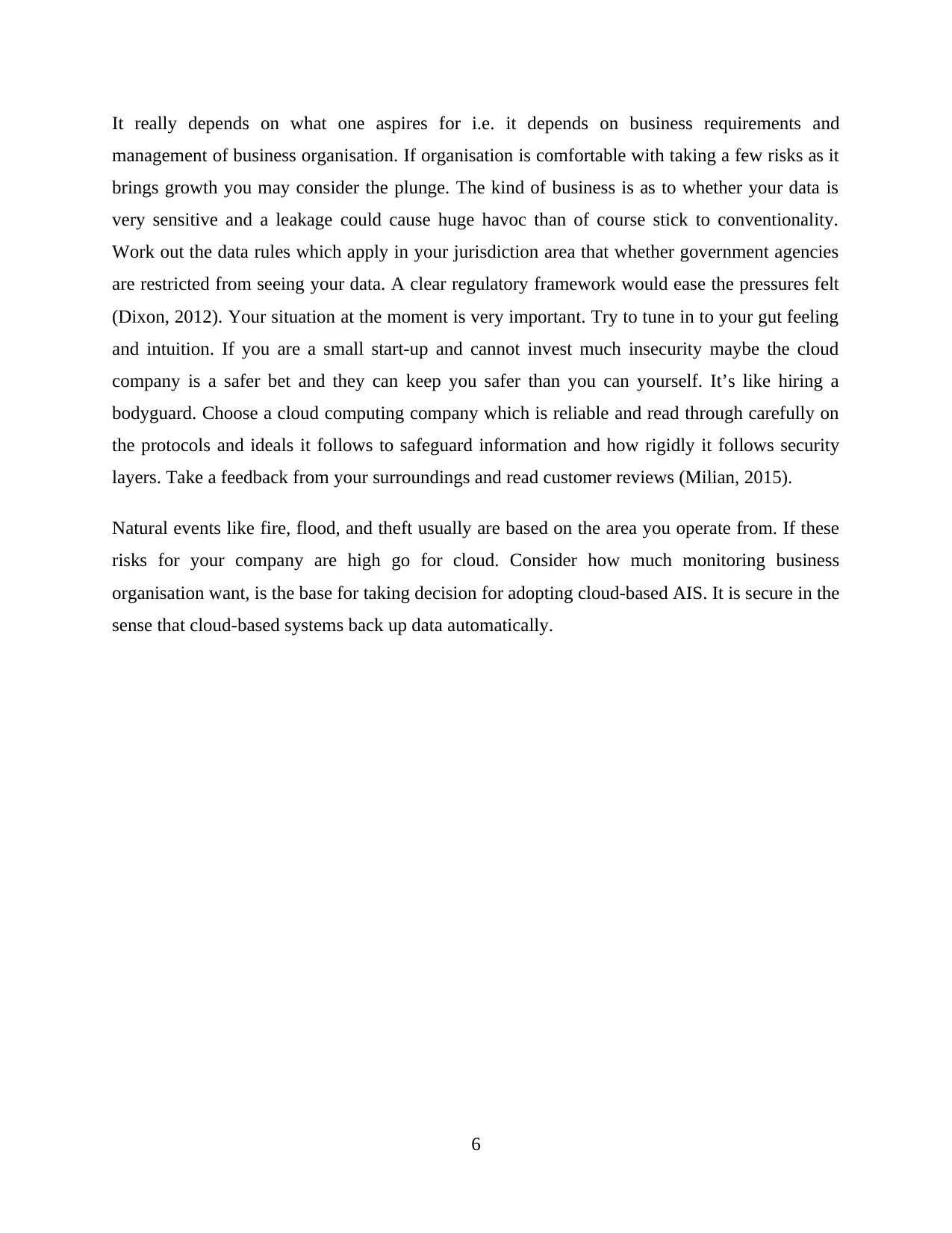
It really depends on what one aspires for i.e. it depends on business requirements and
management of business organisation. If organisation is comfortable with taking a few risks as it
brings growth you may consider the plunge. The kind of business is as to whether your data is
very sensitive and a leakage could cause huge havoc than of course stick to conventionality.
Work out the data rules which apply in your jurisdiction area that whether government agencies
are restricted from seeing your data. A clear regulatory framework would ease the pressures felt
(Dixon, 2012). Your situation at the moment is very important. Try to tune in to your gut feeling
and intuition. If you are a small start-up and cannot invest much insecurity maybe the cloud
company is a safer bet and they can keep you safer than you can yourself. It’s like hiring a
bodyguard. Choose a cloud computing company which is reliable and read through carefully on
the protocols and ideals it follows to safeguard information and how rigidly it follows security
layers. Take a feedback from your surroundings and read customer reviews (Milian, 2015).
Natural events like fire, flood, and theft usually are based on the area you operate from. If these
risks for your company are high go for cloud. Consider how much monitoring business
organisation want, is the base for taking decision for adopting cloud-based AIS. It is secure in the
sense that cloud-based systems back up data automatically.
6
management of business organisation. If organisation is comfortable with taking a few risks as it
brings growth you may consider the plunge. The kind of business is as to whether your data is
very sensitive and a leakage could cause huge havoc than of course stick to conventionality.
Work out the data rules which apply in your jurisdiction area that whether government agencies
are restricted from seeing your data. A clear regulatory framework would ease the pressures felt
(Dixon, 2012). Your situation at the moment is very important. Try to tune in to your gut feeling
and intuition. If you are a small start-up and cannot invest much insecurity maybe the cloud
company is a safer bet and they can keep you safer than you can yourself. It’s like hiring a
bodyguard. Choose a cloud computing company which is reliable and read through carefully on
the protocols and ideals it follows to safeguard information and how rigidly it follows security
layers. Take a feedback from your surroundings and read customer reviews (Milian, 2015).
Natural events like fire, flood, and theft usually are based on the area you operate from. If these
risks for your company are high go for cloud. Consider how much monitoring business
organisation want, is the base for taking decision for adopting cloud-based AIS. It is secure in the
sense that cloud-based systems back up data automatically.
6
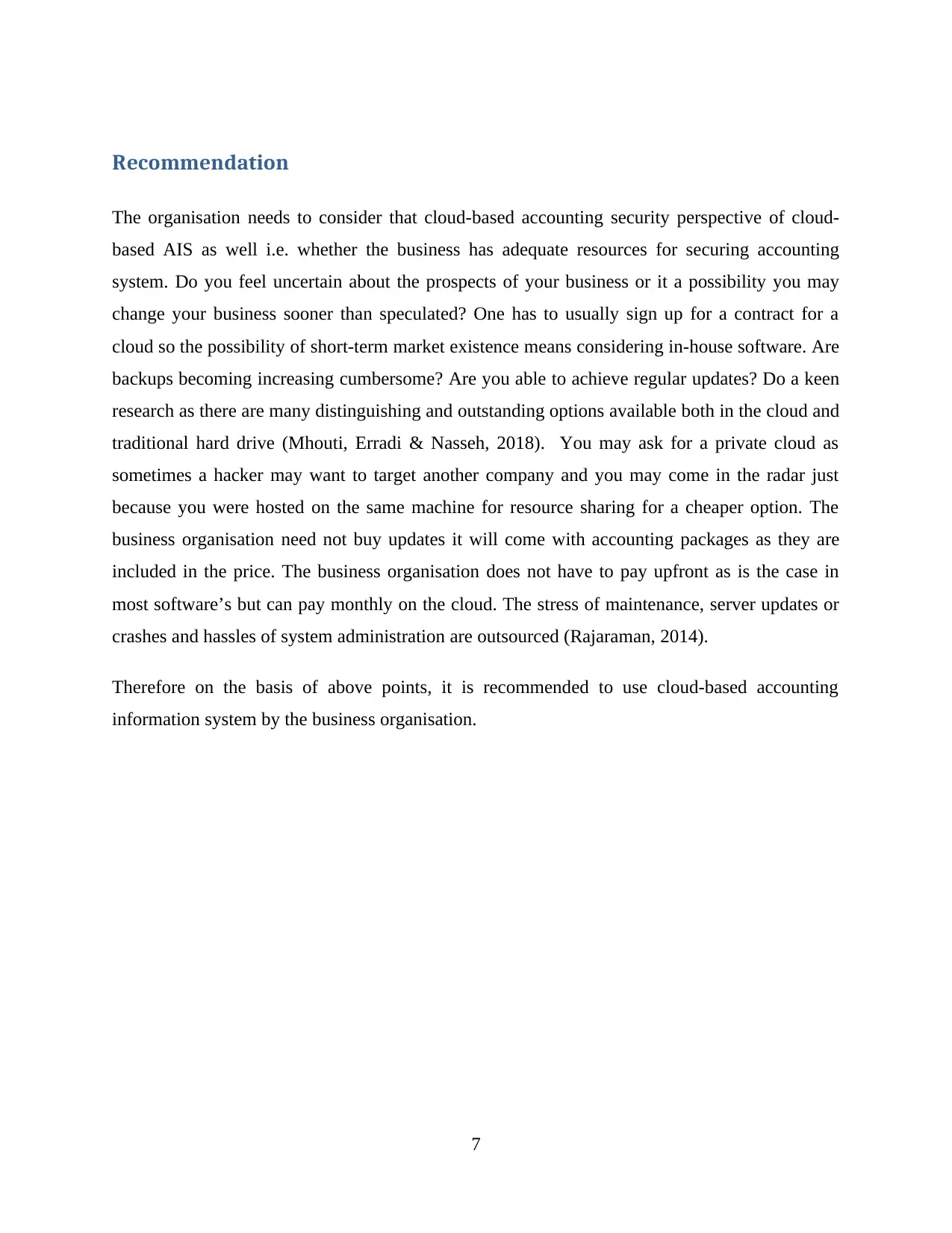
Recommendation
The organisation needs to consider that cloud-based accounting security perspective of cloud-
based AIS as well i.e. whether the business has adequate resources for securing accounting
system. Do you feel uncertain about the prospects of your business or it a possibility you may
change your business sooner than speculated? One has to usually sign up for a contract for a
cloud so the possibility of short-term market existence means considering in-house software. Are
backups becoming increasing cumbersome? Are you able to achieve regular updates? Do a keen
research as there are many distinguishing and outstanding options available both in the cloud and
traditional hard drive (Mhouti, Erradi & Nasseh, 2018). You may ask for a private cloud as
sometimes a hacker may want to target another company and you may come in the radar just
because you were hosted on the same machine for resource sharing for a cheaper option. The
business organisation need not buy updates it will come with accounting packages as they are
included in the price. The business organisation does not have to pay upfront as is the case in
most software’s but can pay monthly on the cloud. The stress of maintenance, server updates or
crashes and hassles of system administration are outsourced (Rajaraman, 2014).
Therefore on the basis of above points, it is recommended to use cloud-based accounting
information system by the business organisation.
7
The organisation needs to consider that cloud-based accounting security perspective of cloud-
based AIS as well i.e. whether the business has adequate resources for securing accounting
system. Do you feel uncertain about the prospects of your business or it a possibility you may
change your business sooner than speculated? One has to usually sign up for a contract for a
cloud so the possibility of short-term market existence means considering in-house software. Are
backups becoming increasing cumbersome? Are you able to achieve regular updates? Do a keen
research as there are many distinguishing and outstanding options available both in the cloud and
traditional hard drive (Mhouti, Erradi & Nasseh, 2018). You may ask for a private cloud as
sometimes a hacker may want to target another company and you may come in the radar just
because you were hosted on the same machine for resource sharing for a cheaper option. The
business organisation need not buy updates it will come with accounting packages as they are
included in the price. The business organisation does not have to pay upfront as is the case in
most software’s but can pay monthly on the cloud. The stress of maintenance, server updates or
crashes and hassles of system administration are outsourced (Rajaraman, 2014).
Therefore on the basis of above points, it is recommended to use cloud-based accounting
information system by the business organisation.
7
Paraphrase This Document
Need a fresh take? Get an instant paraphrase of this document with our AI Paraphraser
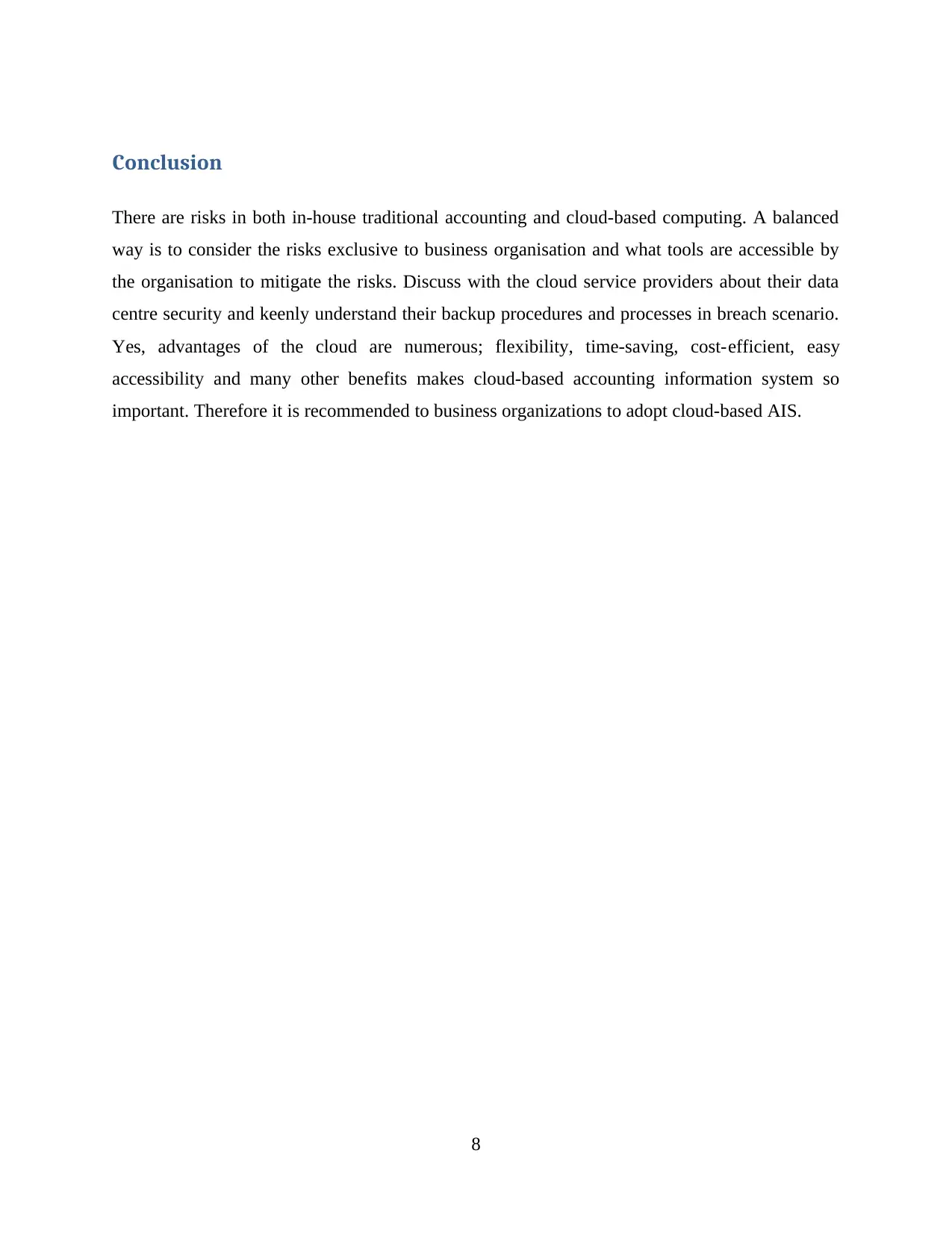
Conclusion
There are risks in both in-house traditional accounting and cloud-based computing. A balanced
way is to consider the risks exclusive to business organisation and what tools are accessible by
the organisation to mitigate the risks. Discuss with the cloud service providers about their data
centre security and keenly understand their backup procedures and processes in breach scenario.
Yes, advantages of the cloud are numerous; flexibility, time-saving, cost-efficient, easy
accessibility and many other benefits makes cloud-based accounting information system so
important. Therefore it is recommended to business organizations to adopt cloud-based AIS.
8
There are risks in both in-house traditional accounting and cloud-based computing. A balanced
way is to consider the risks exclusive to business organisation and what tools are accessible by
the organisation to mitigate the risks. Discuss with the cloud service providers about their data
centre security and keenly understand their backup procedures and processes in breach scenario.
Yes, advantages of the cloud are numerous; flexibility, time-saving, cost-efficient, easy
accessibility and many other benefits makes cloud-based accounting information system so
important. Therefore it is recommended to business organizations to adopt cloud-based AIS.
8
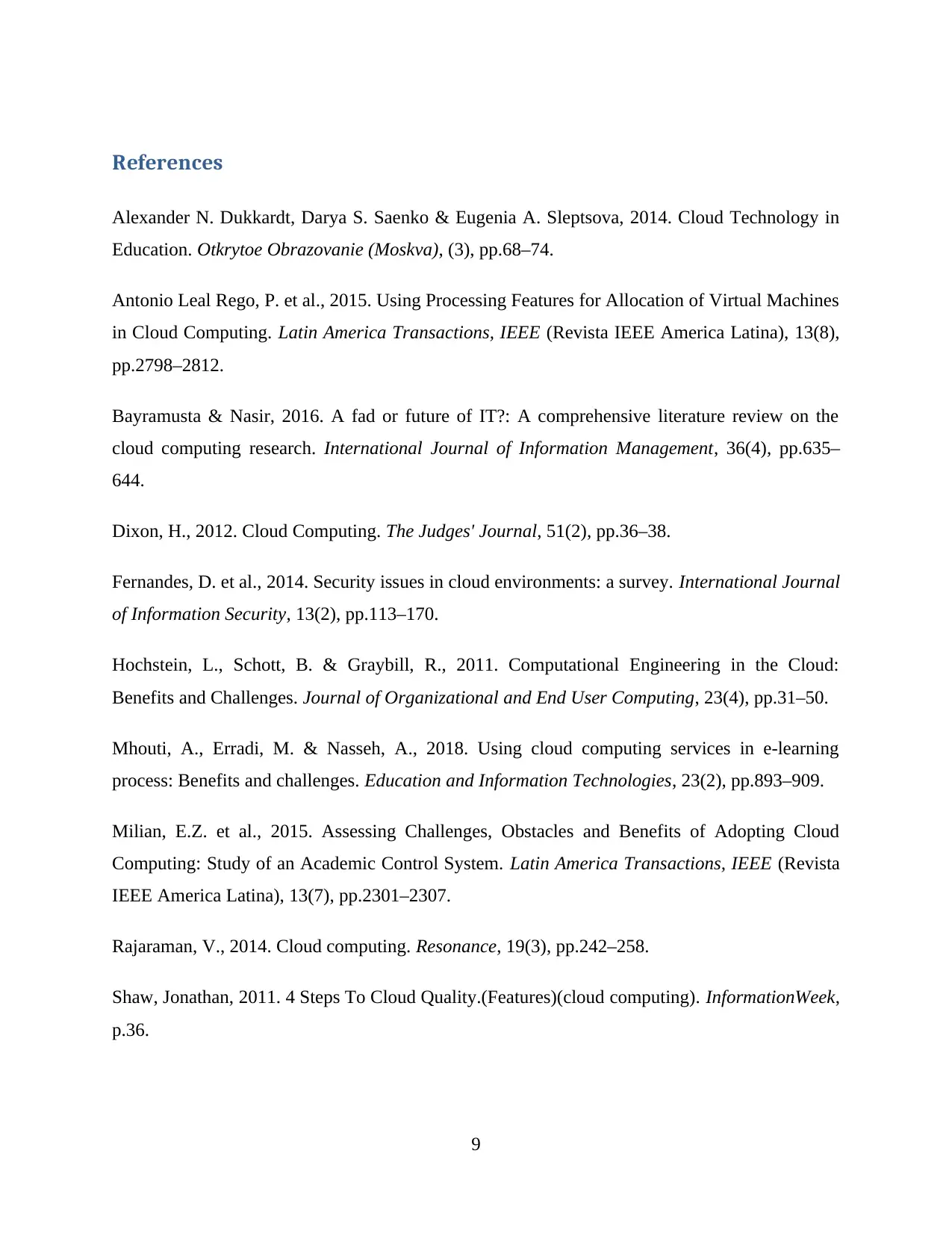
References
Alexander N. Dukkardt, Darya S. Saenko & Eugenia A. Sleptsova, 2014. Cloud Technology in
Education. Otkrytoe Obrazovanie (Moskva), (3), pp.68–74.
Antonio Leal Rego, P. et al., 2015. Using Processing Features for Allocation of Virtual Machines
in Cloud Computing. Latin America Transactions, IEEE (Revista IEEE America Latina), 13(8),
pp.2798–2812.
Bayramusta & Nasir, 2016. A fad or future of IT?: A comprehensive literature review on the
cloud computing research. International Journal of Information Management, 36(4), pp.635–
644.
Dixon, H., 2012. Cloud Computing. The Judges' Journal, 51(2), pp.36–38.
Fernandes, D. et al., 2014. Security issues in cloud environments: a survey. International Journal
of Information Security, 13(2), pp.113–170.
Hochstein, L., Schott, B. & Graybill, R., 2011. Computational Engineering in the Cloud:
Benefits and Challenges. Journal of Organizational and End User Computing, 23(4), pp.31–50.
Mhouti, A., Erradi, M. & Nasseh, A., 2018. Using cloud computing services in e-learning
process: Benefits and challenges. Education and Information Technologies, 23(2), pp.893–909.
Milian, E.Z. et al., 2015. Assessing Challenges, Obstacles and Benefits of Adopting Cloud
Computing: Study of an Academic Control System. Latin America Transactions, IEEE (Revista
IEEE America Latina), 13(7), pp.2301–2307.
Rajaraman, V., 2014. Cloud computing. Resonance, 19(3), pp.242–258.
Shaw, Jonathan, 2011. 4 Steps To Cloud Quality.(Features)(cloud computing). InformationWeek,
p.36.
9
Alexander N. Dukkardt, Darya S. Saenko & Eugenia A. Sleptsova, 2014. Cloud Technology in
Education. Otkrytoe Obrazovanie (Moskva), (3), pp.68–74.
Antonio Leal Rego, P. et al., 2015. Using Processing Features for Allocation of Virtual Machines
in Cloud Computing. Latin America Transactions, IEEE (Revista IEEE America Latina), 13(8),
pp.2798–2812.
Bayramusta & Nasir, 2016. A fad or future of IT?: A comprehensive literature review on the
cloud computing research. International Journal of Information Management, 36(4), pp.635–
644.
Dixon, H., 2012. Cloud Computing. The Judges' Journal, 51(2), pp.36–38.
Fernandes, D. et al., 2014. Security issues in cloud environments: a survey. International Journal
of Information Security, 13(2), pp.113–170.
Hochstein, L., Schott, B. & Graybill, R., 2011. Computational Engineering in the Cloud:
Benefits and Challenges. Journal of Organizational and End User Computing, 23(4), pp.31–50.
Mhouti, A., Erradi, M. & Nasseh, A., 2018. Using cloud computing services in e-learning
process: Benefits and challenges. Education and Information Technologies, 23(2), pp.893–909.
Milian, E.Z. et al., 2015. Assessing Challenges, Obstacles and Benefits of Adopting Cloud
Computing: Study of an Academic Control System. Latin America Transactions, IEEE (Revista
IEEE America Latina), 13(7), pp.2301–2307.
Rajaraman, V., 2014. Cloud computing. Resonance, 19(3), pp.242–258.
Shaw, Jonathan, 2011. 4 Steps To Cloud Quality.(Features)(cloud computing). InformationWeek,
p.36.
9
1 out of 9
Related Documents
Your All-in-One AI-Powered Toolkit for Academic Success.
+13062052269
info@desklib.com
Available 24*7 on WhatsApp / Email
![[object Object]](/_next/static/media/star-bottom.7253800d.svg)
Unlock your academic potential
© 2024 | Zucol Services PVT LTD | All rights reserved.





